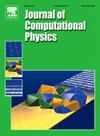海底滑坡双相双层非局域一般粒子动力学模型
IF 3.8
2区 物理与天体物理
Q2 COMPUTER SCIENCE, INTERDISCIPLINARY APPLICATIONS
引用次数: 0
摘要
现有的非局部方法依赖于单层理论,这限制了捕获自由表面变化和模拟海底滑坡中流体与土壤之间动力耦合问题的能力。为了克服上述局限性,本文提出了一种双相双层非局部一般粒子动力学(NGPD)方法。在开发的框架内,整个问题域被划分为两个允许重叠的计算层,即流体层和土壤层。每个阶段在其各自的计算层内满足其自己的运动定律。通过引入人工项和有效粒子移动技术(PST)等关键稳定技术,提高了NGPD方法的数值稳定性。详细介绍了该方法中流体相边界条件和土骨架边界条件。其中,为避免颗粒穿透现象,提出了一种新的土体应力边界。基于太极内核的图形处理单元(GPU)加速在这项工作中被利用来实现并行解决方案。为了验证该方法在模拟海底滑坡问题中的性能,采用该方法研究了四个基准算例,包括一个经典的水下土柱解析解问题和三个水下滑坡实验算例。数值结果表明,该方法具有较好的解决水-土相互作用问题的能力。最后,将该方法应用于实际海底滑坡和地震诱发的海底滑坡模型。本文章由计算机程序翻译,如有差异,请以英文原文为准。
A double-phase double-layer nonlocal general particle dynamics for modeling submarine landslides
The existing nonlocal methods rely on a single-layer theory, which limits the capability to capture the variation of free surface and to simulate dynamic coupling problems between fluid and soil in submarine landslides. To overcome the above limitations, a double-phase double-layer nonlocal general particle dynamics (NGPD) method is proposed in this paper. Within the developed framework, the entire problem domain is divided into two computational layers that are allowed to overlap, the fluid layer and the soil layer. Each phase satisfies its own laws of motion within its respective computational layer. The numerical stability of the novel NGPD method is enhanced by several key stabilization techniques, such as artificial terms and efficient particle shifting technique (PST). The boundary conditions of the fluid phase and soil skeleton in the proposed method are introduced in detail. Among them, a novel stress boundary for soils is proposed to avoid the particle penetration phenomenon. The Graphics Processing Unit (GPU) acceleration based on the Taichi kernel is leveraged in this work to achieve a parallel solution. To validate the performance of the proposed method in simulating submarine landslide problems, four benchmark examples, including a classical underwater soil column problem with analytical solution and three experimental submerged landslide examples, are studied by the proposed method. The numerical results demonstrate that the proposed method possesses the excellent ability to address water-soil interaction in hydromechanical geotechnical problems. Finally, the proposed method is further applied to model a practical submarine landslide and a submarine retrogressive landslide induced by earthquake.
求助全文
通过发布文献求助,成功后即可免费获取论文全文。
去求助
来源期刊

Journal of Computational Physics
物理-计算机:跨学科应用
CiteScore
7.60
自引率
14.60%
发文量
763
审稿时长
5.8 months
期刊介绍:
Journal of Computational Physics thoroughly treats the computational aspects of physical problems, presenting techniques for the numerical solution of mathematical equations arising in all areas of physics. The journal seeks to emphasize methods that cross disciplinary boundaries.
The Journal of Computational Physics also publishes short notes of 4 pages or less (including figures, tables, and references but excluding title pages). Letters to the Editor commenting on articles already published in this Journal will also be considered. Neither notes nor letters should have an abstract.
 求助内容:
求助内容: 应助结果提醒方式:
应助结果提醒方式:


